Astronomers describe that the present-day tilt of the Moon is likely a result of collision-free encounters of the early Moon with small planetary bodies in the inner Solar System.

Caption: Gravitational interactions of small bodies with the Earth-Moon system shortly after its formation.
Credit: Laetitia Lalila
We still don’t know exactly how the Moon formed, but the generally accepted hypothesis is that it formed from debris ejected by the impact of a planet-sized object with the early Earth. However, if this were the case, the Moon should have an inclination of around 50° – whereas the present-day value is of approximately 5°. The discrepancy is huge, but now, Kaveh Pahlevan and Alessandro Morbidelli believe they have finally solved this problem.
They ran a series of simulations and found that a few millions of years after the Moon was formed, the new Earth-Moon system was highly changeable, and had optimal conditions for the ‘excitation’ of the lunar orbit through gravitational encounters. In other words, in that time, the Moon’s (and to a much lesser extent, the Earth’s) tilt was affected by gravitational interactions with other planetary bodies.
The authors suggest that while it’s not certain, there’s quite a high chance that these interactions were responsible for changing the Moon’s tilt to the angle we see today.









